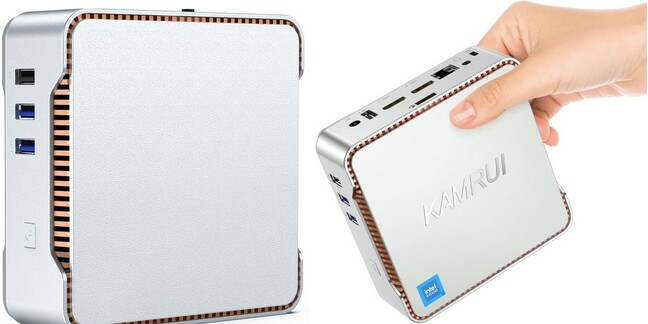A Cheap Chinese PC With Odd Components. What Could Go Wrong?
Desktop Tourism Confession time: I am fascinated by very cheap PCs. I once bought a Windows tablet for AU$50 ($32) and a couple of years ago bought a brand-new Chromebook listed at $AU99.99 ($63) just to see if it was worth even that modest sum.
I never got to test the Chromebook because it was an internet phantom (arranging a refund was no fun at all) but the tablet was terrible (and died after not being used for a year).
I should know better by now, but when I was recently offered the KAMRUI GK3 PLUS Mini-PC, I couldn't resist.
The machine bears the brand of a Chinese company and appears to mostly be sold on sites like Amazon or AliExpress at prices between $200 and $400. Service and support? Maybe they've heard of it.
The PC is powered by an Intel N95, a low-end laptop chip that uses the Alder Lake-N design, boasts four cores, and rumbles along at 1.7 GHz but can peak at 3.4 GHz. A modest Intel GPU is present, along with PCIe 3.0.
A 512 GB M.2 SSD, which Chinese brand BIWIN recommends for use in industrial controllers, provides storage. The 16 GB of RAM, all in a single SODIMM, operates at 2400 MHz and identifies itself as being made by "KINSOTIN," a name that doesn't trouble Google. Kingston Technology is, I assume, too established a company to misspell its own name in product metadata.
Maybe it's best not to ask some questions about this PC.
- You'll [BZZ] like Intel’s [BZZ] NUC 13 Pro once the fan [BZZ] stops blowing
- Your next PC should be a desktop – maybe even this Chinese mini machine
- Microsoft's Surface Pro 9 requires a tedious balancing act
- Lenovo's Yoga 9 is flexible at home, but stretches the friendship at work
The machine matches the template for mini-PCs set by Intel's NUC as it's a 13 cm x 13 cm cuboid, and 6 cm tall. The rear panel features a pair of full-size HDMI slots, a single USB 2.0 slot, a Gigabit Ethernet port, and a microphone input. On the left side of the machine are a power button, another USB 2.0 port, and a pair of USB 3.0 sockets. On the right is a VGA port. Wi-Fi and Bluetooth are within.
This is a bad arrangement because the machine can end up with cables poking in many different directions. USB-C/Thunderbolt is a baffling omission.
The machine is not swift. A Cinebench score of 2,007 is very modest (the Core i7 Intel NUC we recently tested scored 11,461. The PC required 10 minutes and a single second to perform the test we use on every new Desktop Tourism adventure: downscaling a five-minute 4K video to 1080p, slower than all but one of the machines this column has tested. But when we ran Handbrake in an Ubuntu VM under VMware Workstation Pro, it delivered a very respectable 11:23 render time. That's one second faster than an Alder Lake Core i7 laptop we considered earlier this year.
That lack of raw speed doesn't translate to an unpleasant user experience except when the machine is under heavy load. Installing that VM, for example, made for some stuttering moments.
But the machine does behave like a low-end laptop. Waking from sleep would often mean my USB speaker went AWOL. Microsoft Word would sometimes produce blank dialogs after resuming operations.
The machine also had some odd default settings. Bluetooth, for example, was only set up for audio devices, keyboards, and mice. I had to find settings I've never previously considered to connect the smart bicycle trainer I use to ride the cycling metaverse Zwift. That app ran without incident, but with slightly slow startup times.
I don't like KAMRUI's build quality. The machine is light, and its plastic case feels flimsy. The top panel bends easily under pressure and the chromed vents feel especially vulnerable to an accident or just losing their shine.
ASUS is set to revamp its mini-PC range, and KAMRUI's channel and support offerings look very meek in comparison to a global vendor of that caliber. KAMRUI's odd component choices also worry me, as does the fact that the machine appears out of stock three months after I acquired it. With those worries and its little annoyances, I struggle to recommend this machine.
Yet I'm using it most days without incident. My fascination is paying off more with this machine than with the other cheap curiosities I've indulged over the years. For now. ®
From Chip War To Cloud War: The Next Frontier In Global Tech Competition
The global chip war, characterized by intense competition among nations and corporations for supremacy in semiconductor ... Read more
The High Stakes Of Tech Regulation: Security Risks And Market Dynamics
The influence of tech giants in the global economy continues to grow, raising crucial questions about how to balance sec... Read more
The Tyranny Of Instagram Interiors: Why It's Time To Break Free From Algorithm-Driven Aesthetics
Instagram has become a dominant force in shaping interior design trends, offering a seemingly endless stream of inspirat... Read more
The Data Crunch In AI: Strategies For Sustainability
Exploring solutions to the imminent exhaustion of internet data for AI training.As the artificial intelligence (AI) indu... Read more
Google Abandons Four-Year Effort To Remove Cookies From Chrome Browser
After four years of dedicated effort, Google has decided to abandon its plan to remove third-party cookies from its Chro... Read more
LinkedIn Embraces AI And Gamification To Drive User Engagement And Revenue
In an effort to tackle slowing revenue growth and enhance user engagement, LinkedIn is turning to artificial intelligenc... Read more


